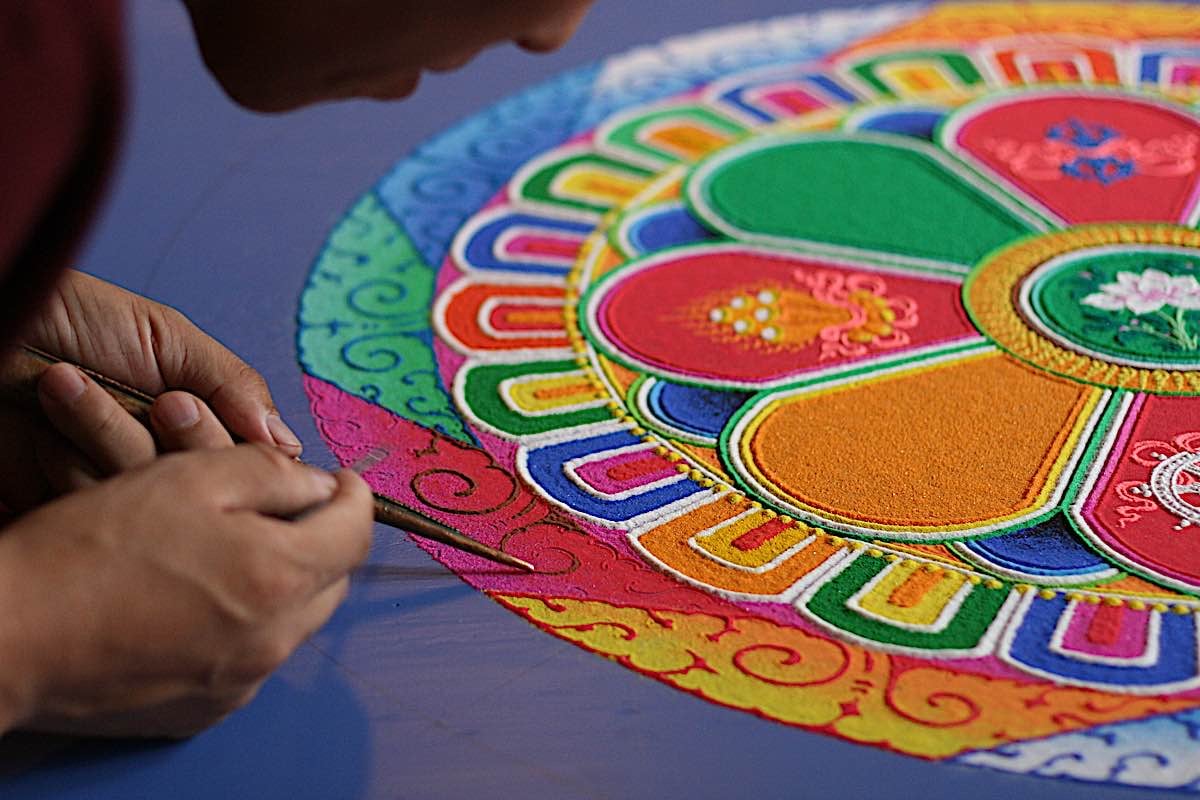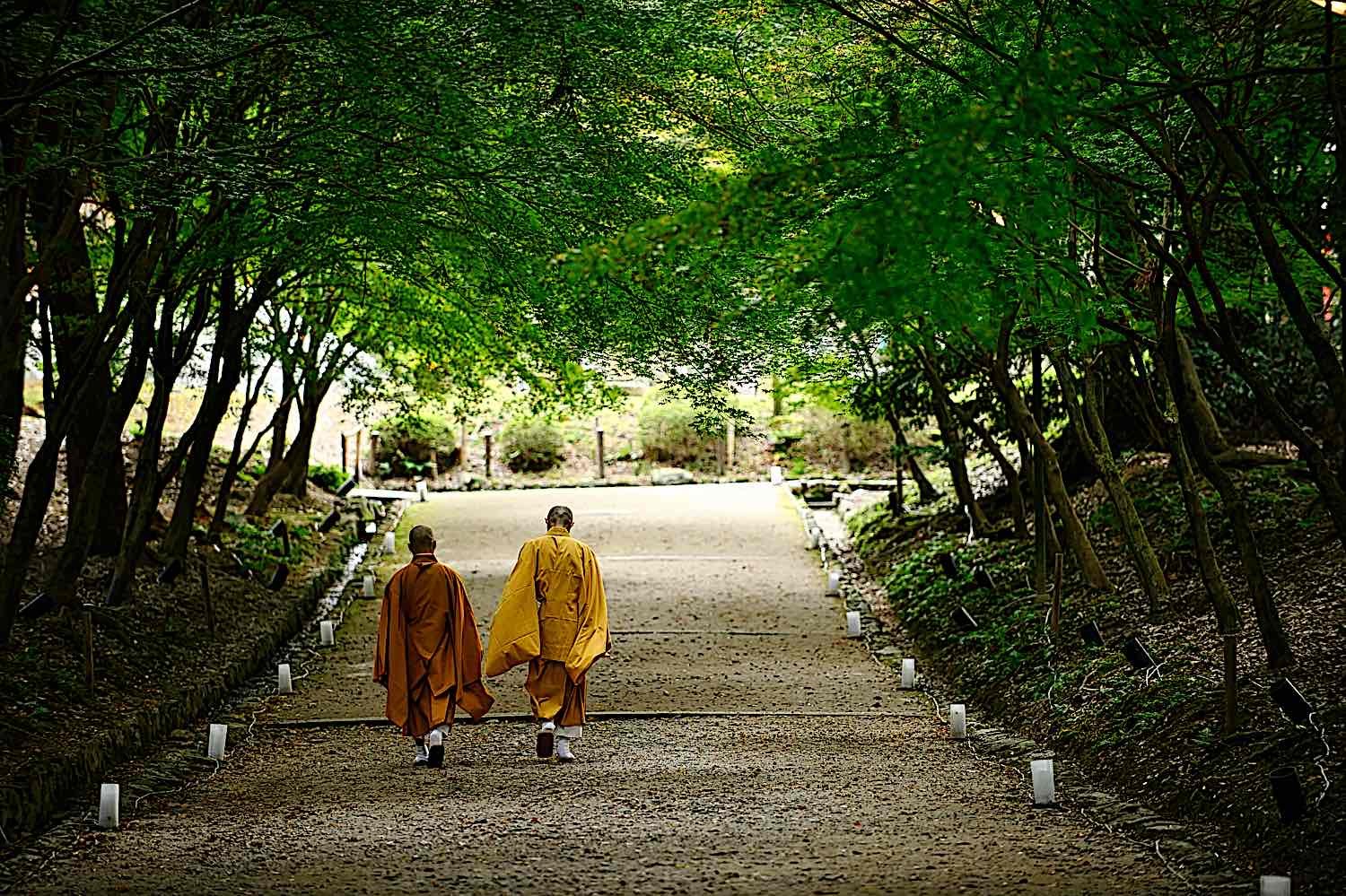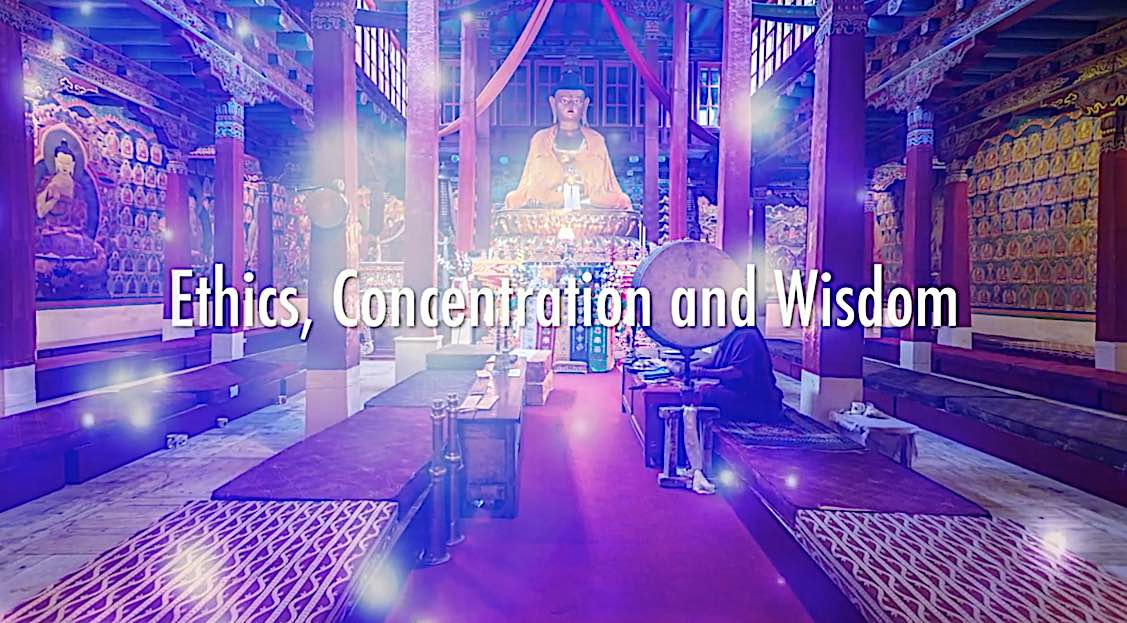The Five Strengths and Powers or pañcabalā in Buddhism — the qualities conducive to Enlightenment: faith, energy, mindfulness, concentration and wisdom

The Chariot of Five Strengths (Sanskrit, Pali: pañcabalā) in Buddhism — critical to our progress on the path to enlightenment — are: faith, energy, mindfulness, concentration, and wisdom. They are one of the seven sets of Bodhipakkhiyadhamma (“qualities conducive to enlightenment”).
You may wonder why our feature image for pancabala is a monk creating an elaborate sand mandala over several days of diligent and skilled work. This single image seems to exemplify all of the five strengths perfectly: the faith required to spend days (energy) mindfully concentrating on the wisdom of Dharma. Perhaps no other visual could have fully accomplished all five so emphatically — and it also demonstrates that the ancient Pali teachings on Pancabala empower all traditions of Buddhism: Theravada, Mahayana, Chan/ Zen, Vajrayana and all the schools or paths.

Buddha taught in Bhāvanānuyutta sutta (the Mental Development Discourse):
‘Monks, although a monk who does not apply himself to the meditative development of his mind may wish, “Oh, that my mind might be free from the taints by non-clinging!”, yet his mind will not be freed. For what reason? “Because he has not developed his mind,” one has to say. Not developed it in what? In the four foundations of mindfulness, the four right kinds of striving, the four bases of success, the five spiritual faculties, the five spiritual powers, the seven factors of enlightenment and the Noble Eightfold Path.
Pancabala: the five strengths or powers
The Five Strengths are also known as the five powers (pañcabala), the five faculties (pañcindriya), or the five strengths of concentration meditation (samadhippakkhiyadhamma).

The five strengths (pañcabala) are:
- śraddhā (faith),
- vīrya (energy),
- smṛti (mindfulness),
- samādhi (concentration),
- prajñā (wisdom).
According to Sutta, the Buddha taught that if we develop these five qualities or strengths, they will ultimately lead us to enlightenment. In a little more detail, the five are (in more detail in sections below):

1. Faith (or trust): We need faith in Buddha and his teachings in order to follow his path. This is not blind faith — Buddha taught us to always verify everything and use discerning wisdom. Once we trust in the Buddha’s teachings — based on discerning logic — ongoing faith gives us courage and hope when things are difficult. It is like a light that shows us the way in the dark. It helps us overcome obstacles to practice.
- For a previous feature on the topic of faith and devotion — and how faith can make you happier see>>

2. Energy (diligence, vitality): We need energy to keep going when things are tough — as it inevitably will be in the practice of Buddhism. It is for this reason you often hear notable Buddhist teachers talking about “obstacles”. The moment we decide to “sit” and meditate, or study sutra, or practice Sadhana, we realize the commitment is extraordinary — the energy and vitality required is life-changing. Where dos our vitality and energy come from? In part, from faith in the teachings — driven by logic. The practice itself, is self-sustaining, as the more you practice, the more “vitality” and energy you’ll find you have available.
- Many practices in Buddhism focus on developing energy, such as “walking meditation” and kung fu practice for Shaolin practitioners and Vajrayana “activity yogas.” For a feature on “Dharma in Motion” see>>

3. Mindfulness: We need mindfulness to be aware of our thoughts, emotions, and actions — to help us concentrate and develop wisdom. Mindfulness helps us to see things as they really are, without being swayed by our likes and dislikes. Remaining in the present moment, mindfully, helps us remove the obstacles of fear and stresses of life — giving us “energy.”

4. Concentration: We need concentration to focus our mind on Buddha’s teachings and put them into practice. Concentration is like a magnifying glass that allows us to see things more clearly. Of course it’s far more than this, but we’ve covered this extensively in our many features on meditation. [For our full section, with many features on meditation and concentration, see>>]

5. Wisdom: We need the wisdom to discern the truth for ourselves, and initially, to see the truth of Buddha’s teachings and how they apply in practical ways to our lives. Above all, Buddhism is a path of self-exploration, of scientific inquiry. Buddha taught, in many sutras, that we should seek the truth for ourselves. He can point the way, but we must discern for ourselves.
- A good example of modern Wisdom are the many Buddhists who are relating to the teachings in scientific terms. See our special section, The Scientific Buddhist>>

The Chariot of the Five Strengths
The Five Strengths are sometimes compared to a chariot (faith is the axle, energy is the reins, mindfulness is the driver, concentration is the wheels, and wisdom is the charioteer). This analogy illustrates how all of the Five Strengths are necessary for us to make progress on the path.
The Five Strengths are also sometimes compared to a house (faith is the foundation, energy is the walls, mindfulness is the roof, concentration is the door, and wisdom is the owner). This analogy shows how all of the Five Strengths are necessary for us to have a well-rounded practice.
No matter how you look at it, developing these five qualities is essential if we want to make progress on Buddha’s path.
Buddha said:
“Concentration is the one thing needful, for without concentration wisdom cannot function at all.”
This means that we need to develop our concentration in order to develop wisdom. But it also means that we need wisdom in order to develop concentration. So they are two sides of the same coin.

Two Types of Strengths: moral and mental
The Five Strengths are often divided into two groups: the first three (faith, energy, and mindfulness) are called the moral virtues or wholesome states (Sanskrit: kusala-dhamma, Pali: sīla-kusalā), while the last two (concentration and wisdom) are called the mental virtues or supra-mundane states (Sanskrit: lokuttara-dhamma, Pali: lokuttara-kusala).
The first three are called moral virtues because they lead us to do good deeds. The last two are called supra-mundane states because they take us beyond the world of our everyday experience.
It is important to note that all Five Strengths are necessary for us to make progress on Buddha’s path. We cannot develop one at the expense of the others. They all need to be developed in harmony if we want to achieve enlightenment.
In Mahayana, especially, this would involve all of the Bodhichitta practices — considered of equal importance to Wisdom practices. Lama Tsongkhapa taught the three most important foundations of practice were renunciation, Bodhichitta, and Shunyata (wisdom discerning emptiness). Renunciation is the practice of moral virtues and Bodhichitta is an application of loving-kindness, metta and the Bodhisattva ideal — both aspects of what could be thought of as “moral virtues. The last principle path refers to wisdom. [For a feature on the Three Principal Paths, see>>]
According to the Wisdom Library describing the Maha Prajnaparamita Sastra:
Pañcabala (पञ्चबल) or Bala refers to the “five strengths” and represents one of the seven classes of the thirty-seven auxiliaries to enlightenment (bodhipākṣika), according to the 2nd century Mahāprajñāpāramitāśāstra chapter XXXI.—Accordingly, “when a mind of sharp knowledge (tīkṣṇajñāna-citta) is acquired, there is “powers” (bala)”. Also, “when the five faculties (pañcendriya) have been developed (vṛddha), they are able to intercept the afflictions (kleśa): this is like the power of a big tree (mahāvṛkṣa) that is able to block off water. These five faculties, when they have been developed, are able to gradually penetrate the profound Dharma (gambhīradharma): this is called ‘power’ (bala).
“Also, “when the five faculties (pañcendriya) have increased and are no longer troubled by the affictions (kleśa), they take the name of strengths (bala). See what has just been said about the five faculties. The five faculties (pañcendriya) and the five strengths (pañcabala) come under the aggregate of volition (saṃskāra-skandha), are always associated, are mental events accompanying the mind; they arise with the mind, endure with the mind and perish with the mind. When one possesses them, the mind is in right concentration (samyaksamādhi); when one does not possess them, the mind falls into wrong concentrations (mithyāsamādhi)”.
The five strengths (pañcabala) have the function of checking (parihāṇa), that is to say, they check the arising of thoughts of desire, hatred and ignorance; they are like a fence around a field, like a lock on a house. When one has acquired them, one no longer falls into the wrong concentrations. This is why they are called “powers” (bala).

Faith – Shraddha
Of the five strengths, Shraddha, or Faith is the most difficult one, for anyone not born and raised as a Buddhist. Faith is earned. It is about trust in the teachings — and in yourself — rather than blind faith in arbitrary doctrine.
Barbara O’Brien — a Zen Buddhist practitioner and author of Rethinking Religion — described the issue of faith from a western perspective:
“Western Buddhists often recoil at the word faith. In a religious context, faith has come to mean stubborn and unquestioning acceptance of dogma. Whether that’s what it’s supposed to mean is a question for another discussion, but in any case, that’s not what Buddhism is about. The Buddha taught us to not accept any teaching, including his, without testing and examining it for ourselves.”
So, if you’re not comfortable with the word faith, think of it instead as trust. Trust in the Buddha’s teachings, and trust in your ability to apply those teachings to your own life and see for yourself that they work. Once you do, use your trust in Buddha’s teachings to propel and empower the remaining four strengths on the path: vīrya (energy), smṛti (mindfulness), samādhi (concentration), and prajñā (wisdom).
It is important to realize that faith does not mean blindly accepting everything you hear. The Buddha was very clear that his teachings should not be accepted on faith alone. They should be put into practice and tested against one’s own experience. This is how we develop our own understanding and wisdom.
The Buddhist scriptures often use the analogy of a goldsmith testing purity of gold by cutting, heating and hammering it. In the same way, we need to put the Dharma to the test in our own lives to see if it is genuine. Only then can we have faith in it.

Energy – Vīrya
Of the five strengths, vīrya is probably the one that most westerners can relate to. We are a culture that values productivity and achievement. We are used to being constantly on the go, juggling multiple tasks and commitments. This can be both good and bad. On the one hand, it keeps us busy and motivated; on the other hand, it can lead to burnout and stress.
In Buddhism, vīrya is not just about working hard. It is also about working smart. It is using our energy wisely so that we are not just running around like a chicken with its head cut off, but actually making progress on our spiritual journey.

One way to do this is to focus on quality rather than quantity. For example, instead of meditating for hours every day, it is better to meditate for a shorter time but with more concentration and mindfulness. In the same way, it is better to perform one act of generosity with a pure heart than to perform many acts without any thought or feeling.
Another way to use our energy wisely is to make sure that we are not wasting time and effort on things that are not helpful or productive. This includes things like gossiping, watching too much TV, surfing the Internet for hours at a time, or engaging in other activities that do not help us grow spiritually.

Mindfulness – Smṛti
Of the five strengths, smṛti is probably the one that is most familiar to westerners — thanks to rapid adoption of this concept as a ‘de-stressing’ method. We are a culture now that values self-awareness and mindfulness. We are used to being constantly bombarded with stimuli from the outside world, and we have become adept at filtering out the noise so that we can focus on what is important.
In Buddhism, smṛti is about maintaining awareness of our thoughts, words and deeds throughout the day. It is about keeping our mind focused on the present moment, so that we are not carried away by distractions or pulled into states of mind that are harmful or unhelpful.

One way to develop smṛti is to practice meditation. This will help you to still your mind and become more aware of your thoughts and emotions. It is also helpful to develop a daily routine that includes time for reflection and self-examination. This can be done through journaling, setting aside time each day for silent contemplation, or talking with a trusted friend or spiritual mentor.
Another way to develop smṛti is to pay attention to your daily activities and see if there are ways in which you can be more present and mindful. For example, instead of rushing through your meals, take the time to savor the taste and texture of your food. Instead of working on autopilot, take the time to really focus on your task at hand. And instead of letting your mind wander when you are talking with someone, really listen to what they are saying.

Samādhi (concentration)
Samadhi, like all the five strengths, is interconnected with the other five. We need concentration, for example, to help us discern wisdom (Prajna) and avoid delusions (Moha). Concentration is also necessary to develop mindfulness (Smriti) and energy (Virya).
Concentration can be defined as the ability to focus the mind on a single object or task. In Buddhism, concentration is not just about mental focus; it is also about emotional stability. When our mind is concentrated, we are less likely to be swayed by our emotions, and we are more likely to act in a wise and helpful way.
There are many different ways to develop concentration. One way is to practice meditation. This can be done through techniques such as mindfulness meditation, where you focus your attention on your breath or a mantra; or through concentration meditation, where you focus your attention on a single object, such as a candle flame or a crystal.
Another way to develop concentration is through yoga or tai chi. These practices help to still the body and mind, and can be very helpful in developing concentration.

Wisdom – Prajñā
Of the five strengths, prajñā is probably the one that is most misunderstood by westerners. We are a culture that values knowledge and intellectual achievement. We are used to thinking of wisdom as something that can be learned from books or acquired through formal education.
In Buddhism, prajñā is not just about acquiring knowledge. It is also about understanding the true nature of reality. It is about seeing things as they really are, rather than seeing them through the lens of our own biases, preconceptions and delusions.
One way to develop prajñā is to study the teachings of the Buddha. This will help you to understand the basic principles of Buddhism and how to apply them in your own life. It is also helpful to read books or articles that challenge your assumptions and broaden your perspectives.
Another way to develop prajñā is to meditate on the teachings of the Buddha. This will help you to really digest and reflect on what you have learned. And it will also help you to develop a deeper understanding of your own mind and how it works.

Bodhipakkhiyādhammā
In addition to the five strengths, Buddha very carefully and logically mapped out the path to Enlightenment in multiple methods and techniques — clearly designed for “self study” and meditation (rather than dogmatic faith-oriented instruction). We’ve covered these in other features, and will cover each in more depth. They include:
Four establishments/presences of mindfulness (cattāro satipaṭṭhānā)
Main article: Satipatthana
- Mindfulness of the body (kāyānupassanā, S. kayānupasthāna)
- Mindfulness of feelings (vedanānupassanā, S. vedanānupasthāna)
- Mindfulness of mental states (cittānupassanā, S. cittanupasthāna)
- Mindfulness of mental qualities (dhammānupassanā, S. dharmanupasthāna)
Four right exertions/efforts/strivings (cattāro sammappadhānā)
Main article: Four Right Exertions
See also: Vīrya
- Effort for the preventing of unskillful states to arise
- Effort for the abandoning of the already arisen unskillful states
- Effort for the arising of skillful states
- Effort for the sustaining and increasing of arisen skillful states
Four bases of spiritual power (cattāro iddhipādā)
- Intention or will (chanda, S. chanda)
- Effort (viriya, S. vīrya)
- Consciousness (citta, S. citta)
- Skill of Analysis (vīmaṁsa or vīmaŋsā, S. mimāṃsā)
Five spiritual faculties (pañca indriya)
- Conviction[7] (saddhā, S. śraddhā)
- Effort (viriya, s. vīrya)
- Mindfulness (sati, S. smṛti)
- Concentration/Unification (samādhi, S. samādhi)
- Wisdom (paññā, S. prajñā)
Five Strengths (pañca bala)
- Conviction (saddhā, S. śraddhā)
- Effort (viriya, S. vīrya)
- Mindfulness (sati, S. smṛti)
- Concentration/Unification (samādhi, S. samādhi)
- Wisdom (paññā, S. prajñā)
Seven Factors of bodhi (awakening, understanding)
- Mindfulness (sati, S. smṛti)
- Investigation (dhamma vicaya, S. dharmapravicaya)
- Effort (viriya, S. vīrya)
- Joy (pīti, S. prīti)
- Tranquillity (passaddhi, S. praśrabdhi)
- Concentration/Unification (samādhi, S. samādhi)
- Equanimity (upekkhā, S. upekṣā)
Noble Eightfold Path
- Right Understanding (sammā diṭṭhi, S. samyag-dṛṣṭi)
- Right Intention (sammā saṅkappa, S. samyak-saṃkalpa)
- Right Speech (sammā vācā, S. samyag-vāc)
- Right Action (sammā kammanta, S. samyak-karmānta)
- Right Livelihood (sammā ājīva, S. samyag-ājīva)
- Right Effort/Energy (sammā vāyāma, S. samyag-vyāyāma)
- Right Mindfulness (sammā sati, S. samyak-smṛti)
- Right Concentration/Unification (sammā samādhi, S. samyak-samādhi) [3]
NOTES
[1] Wisdom Library: Maha Prajnaparamita Sastra >>
[2] Shradda: Faith in Buddhism by Barbara O’Brien on Learning Religions >>
More articles by this author

Samantabhadra’s The King of Prayers is the ultimate Buddhist practice how-to and itself a complete practice

The Five Strengths and Powers or pañcabalā in Buddhism — the qualities conducive to Enlightenment: faith, energy, mindfulness, concentration and wisdom

Tara’s Great Dharani Supreme of all Mantras –with Music version– and the Sutra of Tara Who Protects from the Eight Fears: in Tara’s Own Words
Search
Latest Features
Please support the "Spread the Dharma" mission as one of our heroic Dharma Supporting Members, or with a one-time donation.
Please Help Support the “Spread the Dharma” Mission!

Be a part of the noble mission as a supporting member or a patron, or a volunteer contributor of content.
The power of Dharma to help sentient beings, in part, lies in ensuring access to Buddha’s precious Dharma — the mission of Buddha Weekly. We can’t do it without you!
A non-profit association since 2007, Buddha Weekly published many feature articles, videos, and, podcasts. Please consider supporting the mission to preserve and “Spread the Dharma." Your support as either a patron or a supporting member helps defray the high costs of producing quality Dharma content. Thank you! Learn more here, or become one of our super karma heroes on Patreon.
Lee Kane
Author | Buddha Weekly
Lee Kane is the editor of Buddha Weekly, since 2007. His main focuses as a writer are mindfulness techniques, meditation, Dharma and Sutra commentaries, Buddhist practices, international perspectives and traditions, Vajrayana, Mahayana, Zen. He also covers various events.
Lee also contributes as a writer to various other online magazines and blogs.















